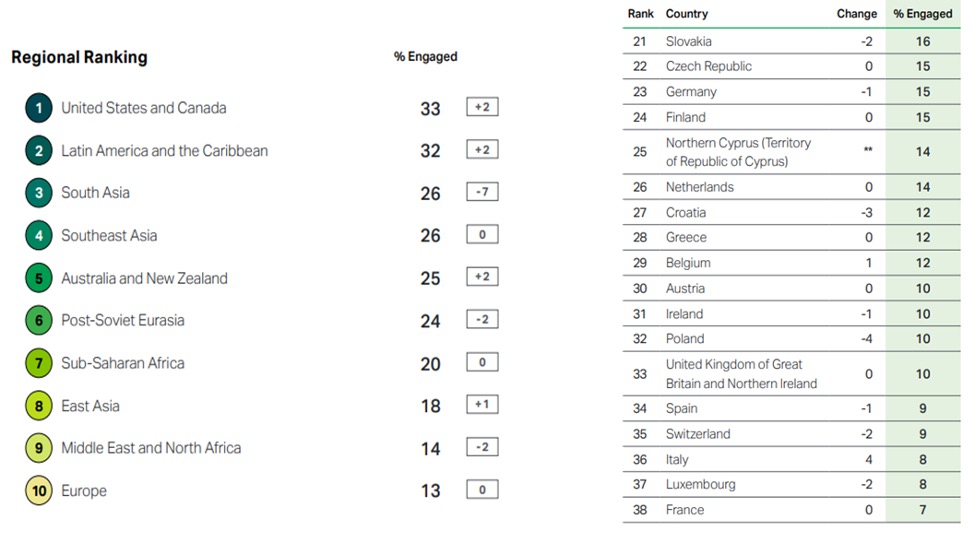One of the most consistently pressing challenges for HR leaders is how to retain and attract high-quality talent. While the Great Resignation may have slowed, McKinsey research suggests that 1-in-3 European workers are considering leaving their jobs in the short term. Coupled with a Europe-wide vacancy rate of 2.7% in late 2023, it’s clear that employers are finding it increasingly difficult to fill positions. This means that organisations are navigating skills gaps, loss of productivity, and soaring recruitment costs.
In this blog, we’ll explore how modern workforce management (WFM) software can help large employers address the challenges of a tight labour market by using technologies that support better workforce experiences. With the right employee management software, companies can retain their best employees and attract new talent in a competitive market.
The High Stakes of Employee Attrition and Engagement
Employee turnover affects every level of an organisation. HR teams bear the brunt—spending excessive time on recruitment and onboarding. In production environments, line managers are left to grapple with reduced productivity, disrupted team dynamics, and the loss of valuable expertise. Remaining employees often face increased workloads and stress, leading to a decline in morale, whilst clients and clients may experience service disruptions and a decline in quality.
Financially, the costs of attrition are steep, with increased expenses tied to recruitment, onboarding, and training. Legal and compliance risks also rise, as a disengaged workforce is more likely to lead to compliance issues and associated liabilities. In short, the impact of employee turnover and disengagement is far-reaching, affecting not just the bottom line but the overall health of the organisation.
Why Employee Engagement is the Key to Talent Retention
Poor workforce experience is a primary driver of attrition. In the EMEA region, particularly countries like France, Spain, Italy, the UK, and Switzerland rank among the lowest in the world for employee engagement. According to Gallup’s “State of the Global Workforce Report 2024,” European employees are among the least engaged globally, creating a pressing need for organisations to address this issue head-on.
Source: Gallup State of the Global Workforce Report 2024
One illustrative case comes from a major UK high street retailer, where exit interviews revealed that poor workforce management practices were a significant factor in employee turnover. Common complaints included short-notice shift changes, paper-based leave requests, lack of communication, unpredictable schedules, and an inability to express views or swap shifts. These issues are not unique to any one industry. Rather, they reflect broader challenges that many organisations face as the workforce at large has begun making careful decisions about where they want to work.
The Role of Workforce Management Software in Enhancing Engagement
Solving the engagement problem requires both cultural and process changes. Whilst perks like wellbeing apps, free snacks, and yoga sessions are nice to have, they are not a substitute for addressing the underlying issues of outdated workforce management practices. Modern workforce management software offers dedicated tools designed to improve employee engagement through engagement practices that meet these essential employee needs.
For example, a consumer-grade mobile app allows employees to manage their availability, swap shifts, and pick up additional shifts that align with their personal needs. Automated scheduling tools help sustain compliant, predictable, and fair schedules, reducing the unpredictability that often leads to employee dissatisfaction. These capabilities provide an improved employee experience that helps people feel valued within their organisation.
One of the most effective ways to address poor engagement is by giving employees a voice. Workforce experience tools can help create easy-to-use communication channels that ensure employees are informed. Similarly, workforce analytics tools equip organisations to constantly analyze employee data, such as unplanned overtime, staffing levels, lateness, and absenteeism, serving to automatically show potential engagement issues. This data-driven approach allows organisations to trigger in-the-moment sentiment surveys, offering real-time insights into employee morale and enabling swift corrective action.
The Cost of Doing Nothing
The consequences of poor employee engagement are well documented—reduced productivity, lost innovation, increased sickness levels, lower quality of work, reputational damage, and ultimately, reduced revenues coupled with higher costs. Some sources say that the actual cost of a new hire with a salary of £27,000 can be as high as £62,890. These figures underscore the significant financial benefits of investing in modern employee management software as a means of better meeting the workforces’ needs to improve engagement and retention.
In a competitive talent market, keeping and attracting top talent is more critical than ever. Modern Workforce Management software offers a comprehensive solution to the challenges posed by employee disengagement and attrition, helping forward-thinking organisations become the employers of choice by top talent. Implementing these tools can help businesses improve employee engagement and retention whilst further driving productivity, reducing costs, and securing a sustainable future in an increasingly challenging landscape.
See our cost savings calculator to see the tangible value that modern workforce management can bring to your organization.
The High Stakes of Employee Attrition and Engagement
Employee turnover affects every level of an organisation. HR teams bear the brunt—spending excessive time on recruitment and onboarding. In production environments, line managers are left to grapple with reduced productivity, disrupted team dynamics, and the loss of valuable expertise. Remaining employees often face increased workloads and stress, leading to a decline in morale, whilst clients and clients may experience service disruptions and a decline in quality.
Financially, the costs of attrition are steep, with increased expenses tied to recruitment, onboarding, and training. Legal and compliance risks also rise, as a disengaged workforce is more likely to lead to compliance issues and associated liabilities. In short, the impact of employee turnover and disengagement is far-reaching, affecting not just the bottom line but the overall health of the organisation.
Why Employee Engagement is the Key to Talent Retention
Poor workforce experience is a primary driver of attrition. In the EMEA region, particularly countries like France, Spain, Italy, the UK, and Switzerland rank among the lowest in the world for employee engagement. According to Gallup’s “State of the Global Workforce Report 2024,” European employees are among the least engaged globally, creating a pressing need for organisations to address this issue head-on.





